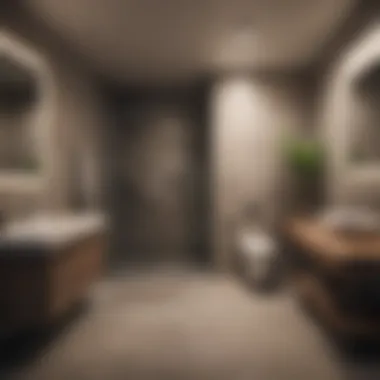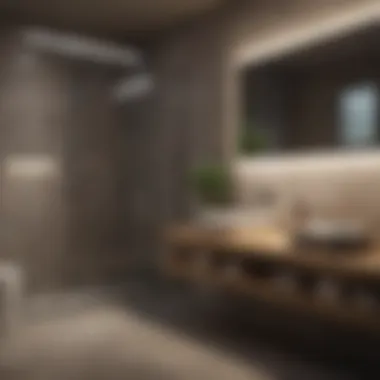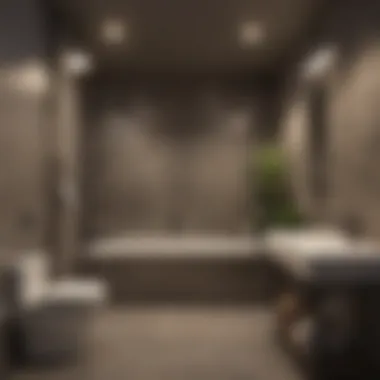Understanding Basement Bathroom Installation Costs


Intro
Adding a bathroom in a basement can enhance the value and functionality of a house. Homeowners often consider this renovation to increase convenience and create additional space for guests. However, understanding the cost of such an installation is crucial for proper budgeting and planning.
This section will outline key considerations related to the associated costs. These factors include labor, materials, permits, and design inspiration. Homeowners should also be aware of potential hidden expenses that could arise during the project. The ultimate goal is to better prepare individuals planning to undertake this type of renovation.
To help navigate this intricate process, the following sections will provide valuable insights into design choices and practical tips that ensure a successful installation of a basement bathroom.
Preface to Basement Bathrooms
Adding a bathroom to a basement is a popular trend for homeowners looking to utilize their space efficiently. This section will delve into the importance of understanding various elements that influence the cost and feasibility of such installations.
This topic is crucial for several reasons. Firstly, basement bathrooms can significantly increase a home's value. This is particularly true in regions where additional facilities appeal to buyers. Secondly, a bathroom in the basement enhances functionality for families. It minimizes the need to go upstairs for basic needs, which is very important in larger homes.
Additionally, this renovation can make the entire living area more comfortable, especially during gatherings or hosting events. However, potential costs can vary widely based on numerous factors, which will be explored in detail throughout this article.
Ultimately, understanding the context and costs associated with installing a bathroom in the basement can empower homeowners to make well-informed renovation decisions.
Definition and Purpose
A basement bathroom generally refers to a functional restroom located in the lower level of a home. Its primary purpose is to provide convenience and add value to the dwelling. This can be done either through new constructions or by remodeling an existing space.
The essential elements of a basement bathroom include a toilet, sink, and typically a shower or tub, depending on the available space. These spaces can also serve as powder rooms or full bathrooms. The demand for these facilities has grown due to the increasing trend towards open-concept living where function meets comfort.
Current Trends in Home Renovation
There are notable trends in home renovation that highlight the growing interest in basement bathrooms. Many homeowners are opting for more versatile spaces, where functionality aligns with design. Implementing a bathroom in a basement contributes to this vision, offering more utility without sacrificing style.
Some trends include:
- Eco-friendly fixtures and finishes: Many homeowners now prioritize sustainable products during renovations.
- Minimalistic designs: There's a shift towards clean, simple aesthetics that maximize small spaces effectively.
- Smart technology: Integration of smart fixtures is becoming common, offering convenience and energy efficiency.
According to recent data, around 30% of basement renovations include bathroom additions, underscoring this shift. This statistic illustrates the broader trend toward enhancing home adaptability.
Adding a bathroom can thus serve not only functional needs but also align with evolving design trends. Understanding these current trends and definitions will provide a solid foundation for discussing cost implications in subsequent sections.
Cost Overview
Understanding the cost overview is essential in evaluating the financial implications of installing a basement bathroom. This section clarifies the crucial financial elements that homeowners need to consider before engaging in this renovation. It’s not just about calculating expenses; it's about understanding the investment you are making in your property.
Average Costs to Install a Basement Bathroom
The average costs for installing a basement bathroom can vary widely based on several factors such as location, size, and the complexity of installation. On average, homeowners might expect to spend between $10,000 to $25,000. This range includes:
- Plumbing installation: The cost of laying necessary plumbing lines can be high, especially if the basement is far from existing water sources.
- Fixtures and fittings: Toilets, sinks, and showers have a broad price range depending on the material and style.
- Construction costs: If walls or flooring need to be modified or installed, this will impact the overall cost.
Homeowners should consult with local contractors to receive more accurate estimates based on specific conditions and requirements.
Regional Variations in Pricing
Regional variations play a significant role in the overall cost of installing a basement bathroom. Construction costs can differ greatly depending on local economies and labor market conditions. For example:
- In urban areas, particularly those with higher living costs like New York City or San Francisco, the costs can rise significantly, sometimes exceeding $30,000.
- Conversely, more rural areas may offer lower labor costs and materials, potentially allowing the cost to dip to $8,000 to $15,000.
"Location, while an often overlooked factor, can have a substantial impact on the budget for your basement bathroom project."
It is advisable for homeowners to conduct thorough research on pricing within their specific regions. This could include checking with local contractors, assessing online platforms for comparisons, or even engaging with neighborhood forums to gather insights about pricing trends in their areas. Understanding these regional dynamics can aid greatly in realistic budget planning.


Key Components of Bathroom Installation
When planning to install a bathroom in your basement, understanding the key components is crucial. Each element significantly influences overall costs and functionality. Homeowners must recognize these aspects to make informed choices that meet their design goals and budget constraints.
Plumbing Costs
Plumbing is often the main element in basement bathroom installation. This involves running water lines and drainage systems. The complexity of plumbing can differ based on the current layout of your basement. If the main sewer line and water supply are far from the new bathroom, costs may climb.
Professional plumbers typically charge based on both labor and materials. Expect to spend anywhere from $1,500 to $5,000 for plumbing work. This may include:
- Installing pipes for sinks, toilets, and showers
- Ensuring proper drainage
- Addressing potential issues with freezing pipes if walls lack sufficient insulation
It is vital to choose high-quality materials, as this can prevent future repairs. Always get multiple quotes from licensed plumbers to find a reasonable price.
Electrical Work Considerations
In addition to plumbing, electrical work is needed for any basement bathroom. This may include installing lights, outlets, and ventilation fans. Electrical codes can vary by region, and it's essential to comply with local standards. Not doing so may result in penalties or future issues with home buyers.
Costs for electrical work can range from $500 to $3,000. Homeowners should consider:
- The type of lighting fixtures
- Placement of outlets for convenience
- Installation of exhaust fans for proper ventilation to avoid moisture buildup
It's wise to hire a licensed electrician who understands local building codes to ensure safety and functionality.
Materials and Fixtures Expenses
The fixtures and materials you choose play a significant role in budgeting. High-quality materials often come with higher upfront costs, but they can increase the bathroom's longevity and aesthetics. Expenses can include:
- Vanities: Prices for vanities range from $300 to over $1,500, depending on size and style.
- Toilets: Standard toilets cost about $150 to $450.
- Showers: Shower kits or custom builds can range from $500 to $3,000.
Additionally, homeowners must think about tile, paint, and other finishing touches. Budgeting for these items ensures a well-rounded project without unexpected costs popping up later.
Tip: Prioritize essential features first, then choose upgrades as your budget allows.
By understanding the costs associated with plumbing, electrical work, and materials, homeowners can confidently proceed with their basement bathroom installation plans. This awareness helps ensure that their investment translates into a functional and stylish addition.
Labor Costs
Labor costs represent a significant portion of the overall budget for installing a basement bathroom. Understanding this element is crucial for homeowners looking to make informed decisions. In general, labor costs can fluctuate based on several factors, including the complexity of the project, the local labor market, and the specific qualifications of the contractors involved. These costs often determine the final price significantly, hence requiring thorough analysis.
Hiring Licensed Contractors
Engaging licensed contractors presents numerous advantages. Firstly, licensed professionals bring a level of expertise that is crucial for navigating the intricacies involved in bathroom installations, especially in a basement setting where plumbing and electrical systems are often more complex. They are also acquainted with local building codes and regulations. This ensures that the work performed meets safety standards and local compliance. Using licensed contractors also implies they carry liability insurance and are able to secure necessary permits on behalf of the homeowner.
However, hiring licensed contractors can come with a higher price tag. Homeowners must balance the higher costs against the potential risks of subpar work that may arise from cheaper, unlicensed workers. It is also advisable to collect multiple quotes and check references before making a decision. In many cases, paying a little more upfront can save money in the long run by reducing the likelihood of future repairs or issues.
DIY vs. Professional Installation
The decision between DIY and professional installation is one that many homeowners confront. DIY projects could seem appealing for their potential to lower labor costs. Many are drawn to videos and tutorials available online, believing that with some tools and guidance, they can undertake the project themselves. However, certain tasks, especially those that involve plumbing or electrical work, can become complicated and may lead to mistakes that can be costly.
Though DIY installation can seem economical, these projects require a good level of skill and often take longer than anticipated. If mistakes are made, they can lead to water damage, mold issues, or code violations, ultimately increasing the total expenditure on repairs. Conversely, professional installations provide reliability as contractors often guarantee their work, offering peace of mind, albeit at a higher initial cost. Homeowners should carefully evaluate their capabilities and comfort level before deciding which route to take.
In summary, labor costs can heavily impact the overall budget for a basement bathroom project. Choosing between hiring professionals or opting for DIY requires careful consideration of factors such as skill level, time availability, and the complexity of the plumbing and electrical work involved.
Permits and Regulations
The installation of a bathroom in your basement is not just a simple home improvement task. It involves adhering to certain permits and regulations found within your local area. Understanding these regulations is essential. Compliance with the rules will ensure your renovation is completed safely and within legal boundaries. Additionally, this knowledge can prevent future complications that could arise from unauthorized work.


Understanding Local Building Codes
Local building codes dictate how construction or alterations should be carried out in your area. These codes vary significantly from one location to another. This means that what is acceptable in one region may not be in another. Common elements covered by building codes include plumbing standards, ventilation requirements, and electrical installations.
Knowing these codes can help avoid fines from local authorities. It will also protect you in case you decide to sell the property in the future. A property with unpermitted work could lower its market value or complicate the sale process. For example, a basement bathroom that does not meet local codes might require expensive adjustments later.
It's advisable to consult with a local building inspector or a licensed contractor. They can provide insights into specific codes applicable to basement bathrooms. This step ensures that your renovation aligns with safety standards and local regulations.
Budgeting for Permit Fees
The cost of permits is another critical aspect of budgeting for your basement bathroom. Most municipalities charge fees for various permits. These might include plumbing permits, electrical permits, and general building permits. These costs can vary widely depending on your location and the scale of your renovation project.
When budgeting for permit fees, consider the following:
- Fee structures can differ: Some areas might have flat fees, while others base costs on project value.
- Plan for additional costs: In some cases, inspections may be required, which might have associated fees.
- Obtain estimates ahead: Contact your local authority for an estimate of permit costs before you begin the project. This proactive step can aid in better financial planning.
Design Considerations
Design considerations play a pivotal role in installing a bathroom in your basement. This is not merely about aesthetics; it encompasses practical aspects that can significantly influence both functionality and cost. A well-planned design can maximize the available space while ensuring that the bathroom meets the needs of its users. The layout is essential to avoid future inconveniences. For example, placing fixtures such as the toilet, shower, and sink in an ergonomic manner saves time and enhances comfort.
Another key factor is plumbing and drainage integration. Basements usually have unique plumbing requirements, which can be challenging but are essential for long-term usability. Think through how the existing plumbing lines will connect to your new fixtures. Adequate drainage is vital for preventing water-related issues later on.
Accessibility is yet another important design element. Ensuring that your basement bathroom is easily accessible for all individuals, regardless of mobility, can enhance the space's usability. This includes considering door widths, ease of entry, and the accessibility of fixtures. Thoughtful design can not only serve daily practical needs but also increase the overall value of your home.
Space Planning Guidelines
Effective space planning entails a careful layout of your basement bathroom. Given the often limited space in basements, utilizing it wisely is crucial. Start by measuring the area to understand what can fit comfortably. Also consider the floor plan. Each component needs space but should not feel cramped.
- Prioritize functionality. Ensure that the layout allows for an unobstructed movement between fixtures.
- Use vertical space. Install storage solutions that go up rather than out to conserve floor area.
- Think about lighting. Natural light can make a small space feel larger and more inviting. If windows are not possible, opt for effective artificial lighting.
Accessibility Features
Incorporating accessibility features in your basement bathroom design enlarges its user base significantly. This is especially important for families with elderly members or individuals with disabilities. A few features to consider include:
- Wider doorways: This accommodates mobility aids like wheelchairs or walkers.
- Grab bars: These can be installed near the toilet and shower to offer support.
- Non-slip flooring: Safety should be a priority, especially in areas prone to moisture.
- A curbless shower: This allows users to enter easily without tripping.
Implementing these elements not only serves practical purposes but can also promote inclusivity in your home. With these design considerations, the likelihood of successful renovations increases, ensuring your basement bathroom serves its purpose for years.
Hidden Costs to Consider
When planning to install a bathroom in your basement, it's crucial to keep in mind the hidden costs that often accompany such projects. These costs can emerge unexpectedly, leading to budget overruns. Understanding these elements helps homeowners prepare financially and avoid surprises.
Water Damage and Mold Issues
Basement bathrooms are susceptible to moisture-related problems. Water damage can occur due to factors like leaks in plumbing or insufficient waterproofing. Mold thrives in damp conditions, leading to health risks and structural damage. Homeowners must account for the cost of remediation and prevention.
- Initial Assessment: A professional inspection may be necessary to identify existing water damage or potential risks. This could involve costs for diagnostic testing.
- Preventive Measures: Installing a sump pump or utilizing waterproof sealants is recommended. The cost for these installations should be factored into the overall budget.
- Remediation Costs: If mold is found, biocides and specialized treatments may be required. The expense for this remediation process is often substantial.
Tip: Including professional help for moisture control during the renovation process can prevent long-term costs associated with water damage and mold problems.
A well-planned basement bathroom should include an effective moisture control strategy to avoid future complications.
Ventilation Needs
Proper ventilation is essential in any bathroom, particularly in basements where humidity can be higher. Inadequate airflow can result in various issues, such as increased humidity levels leading to mold growth.
- Airflow Solutions: Homeowners might consider installing exhaust fans. The costs involved in high-quality ventilation solutions can be significant, but avoiding the costs from poor ventilation later is vital.
- Ductwork Modifications: Existing ductwork may require adjustments or even additional installations. This adds to the overall budget but ensures a healthier indoor environment.
- Energy Efficiency: Investing in energy-efficient ventilation can reduce long-term operational costs. While this might have a higher upfront cost, it offsets energy bills over time.


Conclusion: Keeping track of ventilation requirements protects both the property and the health of its occupants. Take these hidden costs into account when budgeting for a basement bathroom installation.
Financing Options
Exploring financing options is crucial when planning to install a bathroom in your basement. The costs can escalate quickly, making it necessary for homeowners to consider how they will fund this renovation. Understanding the various options available can empower homeowners to make choices that suit their financial circumstances.
Home Improvement Loans
Home improvement loans can be a viable solution for many homeowners looking to finance their basement bathroom installation. Unlike conventional mortgages, these loans focus on the value added by renovations. They typically come with a fixed interest rate and a set repayment period.
Some common types of home improvement loans include:
- Personal loans: These are unsecured loans that can be used for various expenses, including home renovations. Borrowers do not need to use their home as collateral, but interest rates may be higher compared to secured loans.
- Home equity loans: These allow homeowners to borrow against the equity in their home. Since these loans are secured by the property, interest rates are usually lower, making them an attractive option.
- Home equity lines of credit (HELOC): Similar to home equity loans, HELOCs let you access the equity of your home but provide the flexibility of borrowing as needed. This can be useful if renovation costs fluctuate.
Before choosing a loan, it is critical to assess your credit score. A higher score often translates into lower interest rates. It’s also wise to shop around to compare terms from different lenders to find the best deal.
Budgeting Strategies
Effective budgeting is key to managing the costs associated with basement bathroom installation. A well-thought-out budget helps ensure that homeowners can complete the project without facing financial strain.
Here are some strategies to consider:
- Detailed cost breakdown: Start by itemizing all expected costs, including labor, materials, permits, and any potential hidden costs. Comprehensive planning can prevent surprise expenses later in the process.
- Prioritize needs vs. wants: Distinguish between essential features and desired upgrades to keep spending in check. This clarity can guide decisions, particularly when unexpected costs arise.
- Set aside a contingency fund: It is advisable to allocate around 10-20% of the total budget for unforeseen issues, such as plumbing problems or mold remediation. This helps provide a buffer against unexpected expenses.
- Research potential savings: Look for sales, discounts, or promotions on materials and fixtures. Utilizing resources like local home improvement stores or online marketplaces can uncover significant savings.
- Consider financing terms: When financing the project, choose repayment options that do not strain other financial obligations. Making informed decisions about loan terms can greatly impact overall budgeting success.
Remember, a well-planned budget not only helps finance the installation but also enhances the overall quality and satisfaction with the completed bathroom.
By carefully considering financing options and budgeting strategies, homeowners can effectively manage the financial aspects of installing a bathroom in their basement.
Return on Investment
When considering the addition of a basement bathroom, understanding the Return on Investment (ROI) is crucial. This section outlines why ROI matters in this context, evaluating specific elements that reflect the financial benefits of such a renovation. Adding a bathroom is not just about meeting immediate needs; it can strongly affect your home's value as well.
Market Value Impact
A well-planned basement bathroom can significantly elevate a property’s market value. Potential buyers often appreciate the convenience of having an extra bathroom, particularly in homes with multiple floors or larger families. The initial investment may seem substantial. However, studies indicate that homeowners can expect to recoup approximately 50% to 100% of their costs, depending on various factors like location and design finish.
Keep in mind that the perceived value varies by region. In urban areas, where space is limited and homes are often compact, an additional bathroom can be a major selling point. Moreover, trends in modern living emphasize the importance of convenience and functionality. A bathroom in the basement can fulfill both with ease, thus increasing buyer interest.
- Factors Influencing Value:
- Location of the property
- Quality of finishes and materials
- Overall design and integration into existing space
Long-term Benefits of a Basement Bathroom
Investing in a basement bathroom presents more than just a potential increase in property value. It offers numerous long-term benefits that can enhance daily living. First, having an extra bathroom alleviates congestion during busy morning hours. Families often struggle with having only one or two bathrooms. Introducing a bathroom in the basement can ease this stress, providing a practical solution for households.
Additionally, a basement bathroom can also serve as a guest suite amenity. This is particularly useful if you frequently host visitors. Guests appreciate the privacy and comfort that comes with having a dedicated bathroom.
"A basement bathroom is not just an enhancement; it's an opportunity for a better living experience."
By factoring in the increased functionality and convenience, many homeowners find that the bathroom's utility justifies the initial investment. Plus, it can aid in future-proofing your home against changing family dynamics or shifting buyer preferences in the real estate market.
Epilogue
Understanding the cost variables, from labor to materials, permits, and potential hidden fees, is essential. Each aspect plays a critical role in shaping the overall budget. Recognizing these elements enables homeowners to prepare and safeguard against unexpected expenses.
Summary of Key Points
- Average Costs: The basic price range varies significantly, influenced by local markets.
- Labor and Materials: Both labor and quality materials significantly impact costs.
- Permits: Overlooking permits can lead to legal penalties and further expenses.
- Hidden Costs: Issues like water damage can add to financial strain.
- ROI: A basement bathroom can enhance your home's market value.
Final Thoughts on Cost Analysis
Final thoughts underscore the necessity of thorough cost analysis before starting. Homeowners should create a detailed budget plan that factors in all elements mentioned above. Investing time in research can lead to better financial outcomes. Finding the right contractor or evaluating DIY options will also influence cost-effectiveness. In the end, a basement bathroom can greatly improve your living space and increase your home's appeal. The essential message is to remain informed and prepared, as this approach will lead to a successful renovation experience.















